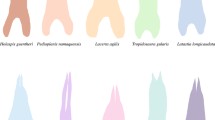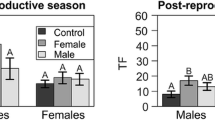Abstract
Comparative data from ten families of lizards suggest that correlated evolution has occurred between the ability to identify prey chemicals and several aspects of lingual function and morphology, abundance of vomeronasal chemoreceptor cells, and foraging behavior. Ability to discriminate prey chemicals from control substances was measured experimentally and correlated with other variables by Felsenstein's method. This ability increased with evolutionary increases in degree of lingual protrusion during tongue-flicking, which may reflect the tongue's ability to reach substrates to be sampled. It increased with deepened lingual forking and greater lingual elongation, which may be important for scent-trailing and sampling ability, respectively. Discriminatory ability also increased with abundance of vomerolfactory chemoreceptors, which presumably reflects some aspects of analytical capacities of the vomeronasal system. Prey chemical discrimination increased with degree of active foraging. Natural selection for improved vomerolfactory sampling and analysis of prey chemicals by active, but not ambush, foragers appears to account for the observed relationships. In active foragers that use vomerolfaction to locate prey, natural selection favors increased abilities to lingually sample chemicals from environmental substrates, analyze the samples for prey chemicals, and respond appropriately if prey chemicals or possible prey chemicals are detected. Such selection can account for the observed relationships among the sampling device and its movements, the sense, the discriminations, and variations in foraging ecology.
Similar content being viewed by others
Author information
Authors and Affiliations
Additional information
Received: 13 February 1997 / Accepted after revision: 12 June 1997
Rights and permissions
About this article
Cite this article
Cooper, W. Correlated evolution of prey chemical discrimination with foraging, lingual morphology and vomeronasal chemoreceptor abundance in lizards. Behav Ecol Sociobiol 41, 257–265 (1997). https://doi.org/10.1007/s002650050387
Issue Date:
DOI: https://doi.org/10.1007/s002650050387




